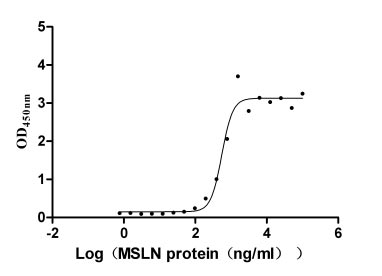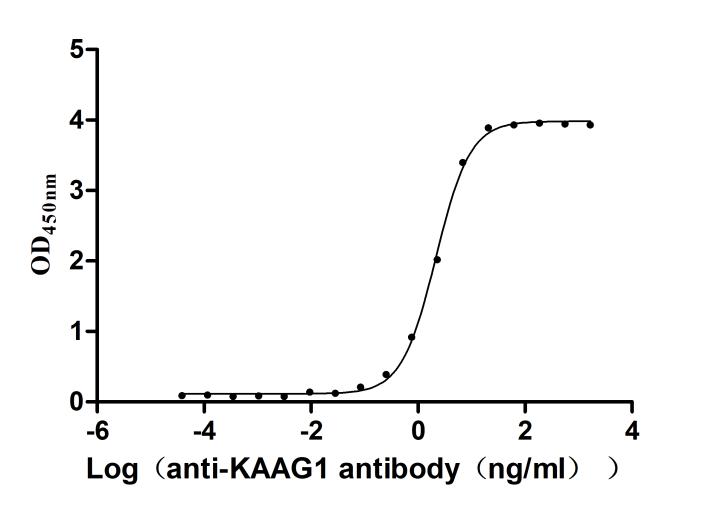Recombinant Human Ubiquitin carboxyl-terminal hydrolase 1 (USP1)
-
中文名称:人USP1重组蛋白
-
货号:CSB-YP025695HU
-
规格:
-
来源:Yeast
-
其他:
-
中文名称:人USP1重组蛋白
-
货号:CSB-EP025695HU
-
规格:
-
来源:E.coli
-
其他:
-
中文名称:人USP1重组蛋白
-
货号:CSB-EP025695HU-B
-
规格:
-
来源:E.coli
-
共轭:Avi-tag Biotinylated
E. coli biotin ligase (BirA) is highly specific in covalently attaching biotin to the 15 amino acid AviTag peptide. This recombinant protein was biotinylated in vivo by AviTag-BirA technology, which method is BriA catalyzes amide linkage between the biotin and the specific lysine of the AviTag.
-
其他:
-
中文名称:人USP1重组蛋白
-
货号:CSB-BP025695HU
-
规格:
-
来源:Baculovirus
-
其他:
-
中文名称:人USP1重组蛋白
-
货号:CSB-MP025695HU
-
规格:
-
来源:Mammalian cell
-
其他:
产品详情
-
纯度:>85% (SDS-PAGE)
-
基因名:
-
Uniprot No.:
-
别名:Deubiquitinating enzyme 1; hUBP; Ubiquitin carboxyl terminal hydrolase 1; Ubiquitin carboxyl-terminal hydrolase 1; Ubiquitin specific peptidase 1; Ubiquitin specific protease 1; Ubiquitin thioesterase 1; Ubiquitin thiolesterase 1; Ubiquitin-specific-processing protease 1; UBP; UBP1_HUMAN; USP 1; Usp1
-
种属:Homo sapiens (Human)
-
蛋白长度:Full length protein
-
表达区域:1-785
-
氨基酸序列MPGVIPSESN GLSRGSPSKK NRLSLKFFQK KETKRALDFT DSQENEEKAS EYRASEIDQV VPAAQSSPIN CEKRENLLPF VGLNNLGNTC YLNSILQVLY FCPGFKSGVK HLFNIISRKK EALKDEANQK DKGNCKEDSL ASYELICSLQ SLIISVEQLQ ASFLLNPEKY TDELATQPRR LLNTLRELNP MYEGYLQHDA QEVLQCILGN IQETCQLLKK EEVKNVAELP TKVEEIPHPK EEMNGINSIE MDSMRHSEDF KEKLPKGNGK RKSDTEFGNM KKKVKLSKEH QSLEENQRQT RSKRKATSDT LESPPKIIPK YISENESPRP SQKKSRVKIN WLKSATKQPS ILSKFCSLGK ITTNQGVKGQ SKENECDPEE DLGKCESDNT TNGCGLESPG NTVTPVNVNE VKPINKGEEQ IGFELVEKLF QGQLVLRTRC LECESLTERR EDFQDISVPV QEDELSKVEE SSEISPEPKT EMKTLRWAIS QFASVERIVG EDKYFCENCH HYTEAERSLL FDKMPEVITI HLKCFAASGL EFDCYGGGLS KINTPLLTPL KLSLEEWSTK PTNDSYGLFA VVMHSGITIS SGHYTASVKV TDLNSLELDK GNFVVDQMCE IGKPEPLNEE EARGVVENYN DEEVSIRVGG NTQPSKVLNK KNVEAIGLLG GQKSKADYEL YNKASNPDKV ASTAFAENRN SETSDTTGTH ESDRNKESSD QTGINISGFE NKISYVVQSL KEYEGKWLLF DDSEVKVTEE KDFLNSLSPS TSPTSTPYLL FYKKL
-
蛋白标签:Tag type will be determined during the manufacturing process.
The tag type will be determined during production process. If you have specified tag type, please tell us and we will develop the specified tag preferentially. -
产品提供形式:Lyophilized powder
Note: We will preferentially ship the format that we have in stock, however, if you have any special requirement for the format, please remark your requirement when placing the order, we will prepare according to your demand. -
复溶:We recommend that this vial be briefly centrifuged prior to opening to bring the contents to the bottom. Please reconstitute protein in deionized sterile water to a concentration of 0.1-1.0 mg/mL.We recommend to add 5-50% of glycerol (final concentration) and aliquot for long-term storage at -20℃/-80℃. Our default final concentration of glycerol is 50%. Customers could use it as reference.
-
储存条件:Store at -20°C/-80°C upon receipt, aliquoting is necessary for mutiple use. Avoid repeated freeze-thaw cycles.
-
保质期:The shelf life is related to many factors, storage state, buffer ingredients, storage temperature and the stability of the protein itself.
Generally, the shelf life of liquid form is 6 months at -20°C/-80°C. The shelf life of lyophilized form is 12 months at -20°C/-80°C. -
货期:Delivery time may differ from different purchasing way or location, please kindly consult your local distributors for specific delivery time.Note: All of our proteins are default shipped with normal blue ice packs, if you request to ship with dry ice, please communicate with us in advance and extra fees will be charged.
-
注意事项:Repeated freezing and thawing is not recommended. Store working aliquots at 4°C for up to one week.
-
Datasheet :Please contact us to get it.
相关产品
靶点详情
-
功能:Negative regulator of DNA damage repair which specifically deubiquitinates monoubiquitinated FANCD2. Also involved in PCNA-mediated translesion synthesis (TLS) by deubiquitinating monoubiquitinated PCNA. Has almost no deubiquitinating activity by itself and requires the interaction with WDR48 to have a high activity.
-
基因功能参考文献:
- USP1 and capital ER, Cyrilliccapital EN, Cyrillic domain of Bcr-Abl oncoprotein colocalize in a model chronic myeloid leukemia cell system. PMID: 30480413
- Our preclinical studies provide the framework for clinical evaluation of USP1 inhibitors, alone or in combination, as a potential novel multiple myeloma therapy. PMID: 28270494
- There is evidence that USP1/WDR48 complex promotes cancer stem cell conservation and regulation of DNA damage repair. [REVIEW] PMID: 28302046
- These results outline a novel mechanism for the control of TBK1 activity and suggest USP1-UAF1 complex as a potential target for the prevention of viral diseases. PMID: 29138248
- USP1 is a key senescence regulator controlling genomic integrity. PMID: 27160904
- High USP1 expression is associated with glioma. PMID: 26951930
- USP1-UAF1 complex promotes homologous recombination repair via multiple mechanisms: through FANCD2 deubiquitination, as well as by interacting with RAD51AP1. PMID: 27463890
- The results suggest that silencing USP1 inhibits cell proliferation and invasion in U2OS cells. Therefore, USP1 may provide a novel therapeutic target for the treatment of osteosarcoma. PMID: 27840911
- Translational regulation of the mRNA encoding USP1 is involved in the DNA damage response as a determinant of cisplatin resistance. PMID: 26825230
- Ubiquitination-specific proteases 1 (USP1)-mediated protein stabilization promotes glioblastoma (GBM) stem-like cells maintenance and treatment resistance, thereby providing a rationale for USP1 inhibition as a potential therapeutic approach against GBM. PMID: 26032834
- analysis of the function and regulation of the USP1-UAF1 complex PMID: 26758085
- USP1, p21 and Spartan are translesion DNA synthesis regulators. (Review) PMID: 26002196
- No correlation was observed between the protein level of ubiquitin-specific protease 1 (USP1) and ubiquitinated PCNA in BAF180 expressing cells PMID: 26117423
- USP1 phosphorylation at S313 is not critical for PCNA deubiquitination, neither for binding to UAF1 in a cellular environment. PMID: 25744535
- Coimmunoprecipitation experiments indicated that human papillomavirus type 31 E1 assembles into a ternary complex with UAF1 and any one of these three USPs: USP1, USP12 and USP46. PMID: 24850727
- Our findings revealed an intriguing mechanism of regulating USP1 activity that combines phosphorylation of a key serine residue in USP1 and the specific interaction of USP1 with a WD40-repeat protein UAF1 PMID: 23116119
- USP1 and UAF1 form a complex in the cytoplasm that subsequently translocates to the nucleus through import mediated by USP1 nuclear localization signals. PMID: 22701671
- data identified a novel USP1-PHLPP1-Akt signaling axis, and decreased USP1 level in lung cancer cells may play an important role in lung cancer progress. PMID: 22426999
- Studies indicate that USP1 and ELG1 as regulators of PCNA ubiquitylation. PMID: 21640107
- Study shows that the deubiquitinating enzyme USP1 promotes ID protein stability and stem cell-like characteristics in osteosarcoma. PMID: 21925315
- USP1 levels were kept low in G1 to provide a permissive condition for inducing proliferating cell nuclear antigen (PCNA) monoubiquitination in response to ultraviolet (UV) damage before DNA replication. PMID: 21768287
- USP1-regulated and damage-specific DNA-binding protein 1 (DDB1)-dependent mechanisms that are involved in the downregulation of activated CHK1 in human cells. PMID: 21389083
- USP1 deubiquitinates FANCD2 protein when cells exit S phase or recommence cycling after a DNA damage insult and may play a critical role in the Fanconi anemia pathway by recycling FANCD2. PMID: 15694335
显示更多
收起更多
-
亚细胞定位:Nucleus.
-
蛋白家族:Peptidase C19 family
-
数据库链接:
HGNC: 12607
OMIM: 603478
KEGG: hsa:7398
STRING: 9606.ENSP00000343526
UniGene: Hs.35086
Most popular with customers
-
Recombinant Human Mucin-16 (MUC16), partial (Active)
Express system: Mammalian cell
Species: Homo sapiens (Human)
-
Recombinant Human Tyrosine-protein kinase Mer (MERTK), partial (Active)
Express system: Mammalian cell
Species: Homo sapiens (Human)
-
Recombinant Human Kidney-associated antigen 1(KAAG1) (Active)
Express system: E.coli
Species: Homo sapiens (Human)
-
Express system: Mammalian cell
Species: Homo sapiens (Human)
















